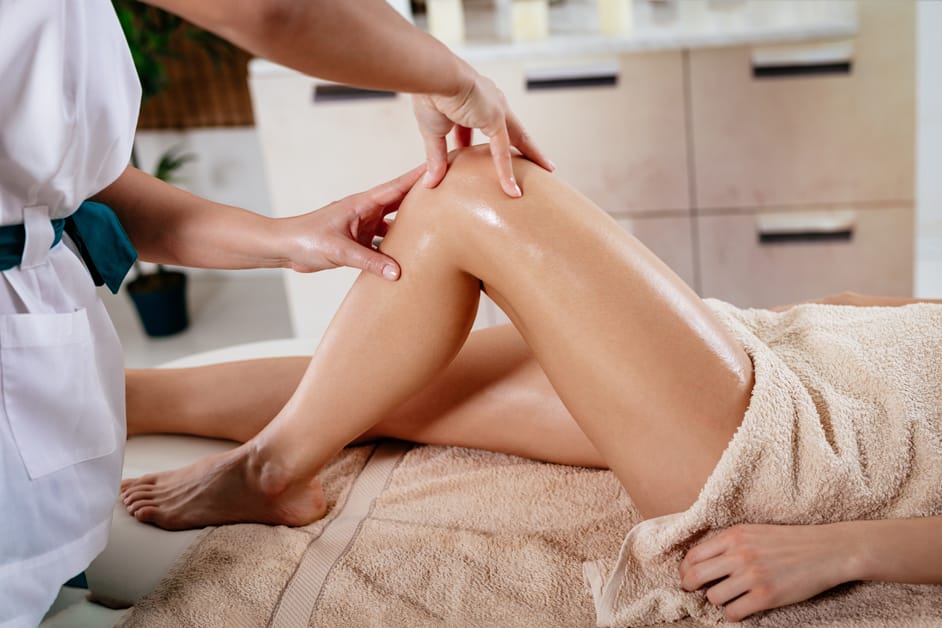Introduction
Massage therapy is a popular practice to reduce pain, increase circulation and support the body’s natural healing. It boosts healing by increasing blood flow and relaxing muscle tension. It’s also an effective treatment for knee pain caused by wear and tear.
This article will give you details on massage therapy for knee relief. It’ll also tell you how to find a reliable massage therapist and how often to get massages for maximum knee pain relief.
Causes of Knee Pain
Knee pain can have a range of sources. It could be the result of years of overuse, age-related problems, injuries, illnesses and medical conditions. To work out the best way to treat it, you must identify the cause.
Here’s a deeper look at the causes of knee pain:
Wear and tear
Wear and tear, also called degenerative joint disease, is a frequent cause of knee pain. Cartilage that cushions bones wears down or breaks away, causing pain and stiffness.
A few causes of wear and tear are age-related changes, obesity, improper knee use, and sports injuries. Massage therapy can help reduce the knee pain caused by wear and tear. It improves circulation to painful areas, relaxes tight muscles, and reduces inflammation. Physical therapists may suggest strength-training exercises, with regular massage sessions helping to slow down the joint deterioration and strengthen muscles around the joints.
Injury
Knee pain may be caused by an injury to the joint, like a sprained ligament or torn cartilage. Osteoarthritis and rheumatoid arthritis can also cause severe knee pain. It is important to see a doctor for diagnosis and treatment.
Sports injuries often cause knee pain too. Runner’s Knee is an umbrella term used to describe several forms of overuse injury. Anterior Cruciate Ligament (ACL) Injury is usually caused by sudden stops or hard hits to the knee. Tendonitis (Jumper’s Knee) is caused by excessive force applied to the patellar tendon. A Meniscus Tear occurs due to rotational force combined with weight bearing activities.
Overuse
Knee pain can be a common thing due to wear and tear from daily activities. This is often caused by overusing the knee joint, which can come from repetitive motions or too much physical activity. Overuse injuries are common with people doing more intense activities, like running or sports.
Activities such as walking up and down stairs, squatting, kneeling, jumping or running on hard surfaces, and carrying too much weight when doing barbell squats, can lead to overuse injuries.
If someone experiences severe pain after physical activity for more than several hours and it does not improve with rest, it may be due to swelling in the joint due to irritation or inflammation of the muscles and tendons. This usually needs medical attention. Anti-inflammatory medication, icing, hot/cold compresses, or massage therapy can help reduce the symptoms.
Massage therapy increases circulation, breaks down tension, and reduces inflammation. It can also increase blood flow and oxygenation, which helps with the healing process. Along with proper exercise form guidance from a health professional, massage may be useful for reducing symptoms from knee overuse injuries.
Massage Therapy Benefits
Massage therapy is a great way to help knee pain caused by wear and tear. It’s not only calming and peaceful, but also an excellent way to reduce pain, stiffness and increase mobility in the knee.
Now let’s look at how it can be helpful!
Increases circulation
Massage therapy increases circulation to the knee joint by applying pressure. Our bodies react to external stimulation, and massage is a great form of active stimulation. When our muscles are manipulated, increased movement sends fresh, enriched blood cells to the area. This helps flush out build-up, and carries away damaged cell material. Moreover, extra circulation gives the knee oxygen-rich blood which helps it heal faster and reduce pain.
Reduces inflammation
Massage therapy has many benefits. It reduces inflammation, which can lead to physical and mental health problems. It works by increasing oxygen in the bloodstream and removing toxins from muscle tissue. This reduces pain and stimulates circulation.
Massage also increases flexibility, making joints move through full ranges of motion more easily. This reduces stress on muscles and soreness after exercise or physical activity.
Massage therapists can use gliding and contact point techniques to target affected areas and reduce knotting or tightness in muscles fibers. Connective tissues can be manipulated to improve flexibility and increase mobility. This can help speed up recovery from injury or health condition.
Improves range of motion
Massage therapy can help enhance range of motion in the knee. It can also reduce pain due to wear and tear, as well as scar tissue caused by surgery or injury. The massage should be specific to the joint and muscles nearby. For instance, if the quadriceps are tense, massage them. Moreover, if the IT band is tight or painful around the knee, address it.
Generally, gentle but firm pressure is advised to encourage release of tension in and around the knee. Massage can move fluids back into healthy circulation and feed damaged areas. By improving circulation, massage can also aid healing and alleviate pain.
Types of Massage Therapy
Massage is a great way to manage knee pain.
- Swedish massage is a popular choice. It works well.
- Deep tissue and trigger point therapies target deeper layers.
- Sports massage is also an option.
It’s important to know the pros and cons of each type, before choosing.
Swedish Massage
Swedish massage is a popular form of massage therapy. It can help relieve knee pain due to wear and tear. The strokes are often long and gentle, or firm, depending on you. It may also include kneading, tapping, stretching and rolling.
This massage boosts blood flow. It supplies oxygen and nutrients to damaged tissues. It reduces inflammation caused by stress or injury, thus reducing knee discomfort. It also increases joint flexibility and range of motion. This is important for keeping mobility in the long run.
Deep Tissue Massage
Deep tissue massage is a type of massage that focuses on the deeper layers of muscle and connective tissue. It’s used to help relieve chronic tension, improve posture, reduce scar tissue, and remove toxins. Strokes are slower and firmer than other massage therapies.
The main focus is to target small knots in the muscle, known as trigger points. These can cause irritation and inflammation throughout the body. Trigger points develop from injuries, strain, or stress on one area of the body. By targeting these knots of tension, deep tissue massage can reduce pain caused by wear and tear on joints, like the knee.
During a session, your therapist may use pressure point techniques to break down adhesions in muscle fibers. They’ll also work on lengthening muscles that have been shortened due to repetitive use. Stretching them with slow strokes and pressure techniques, further relieves tightness in joints caused by wear and tear.
Trigger Point Therapy
Trigger point therapy is a massage technique targeting dense, tender muscles knots that can bring on long-term pain. Muscles become stressed or injured and that leads to metabolites, like lactic acid, accumulating in high-strain areas. Doctors prescribe trigger point therapy for chronic knee pain due to overuse or age/injury.
Trigger points are found by palpating the area. Then, they are manipulated to break up scar tissue and reduce the tension in the muscles. Trigger point therapy is brief, but after each session, your practitioner may suggest taking a few days off to rest before light exercises.
Common techniques used are:
- Rhythmic compression
- Manual pressure with friction
- Cross-fiber strokes
The aim is to restore mobility, enhance bodily function and performance, and offer relief from knee pain caused by age/injury or wear and tear.
Additional Treatment Options
Massage Therapy is great for knee pain from wear and tear. It can help ease tension and reduce inflammation. This leads to improved range of motion and mobility.
There are other treatments too! Let’s explore these options and see how effective they are:
Physical Therapy
Physical therapy can be a great part of treating knee pain. Exercises and stretches strengthen muscles, increase flexibility, and reduce joint instability. Your doctor or surgeon may recommend these exercises:
- Calf raises are for strengthening the quads and stretching hamstrings.
- Straight leg raises promote strength in the hip and knee.
- Side steps promote strength, balance, and motion.
- Quadriceps sets strengthen at the top of the thigh.
- Resisted motions increase hip and knee stability.
Physical therapy could include ultrasound or electrical stimulation to help with inflammation and healing. Massage therapy can help reduce pain, improve mobility, reduce inflammation, improve circulation, and release scar tissue around injuries.
Exercise
Exercise is essential for managing knee pain. Strengthening and stretching the muscles that support the joint can reduce stress on it and improve circulation.
Weight or resistance training, or a combination of both, are great strengthening exercises. Stretching should be gentle. Examples are knee bends, wall squats, calf stretches, hip flexor stretches, hamstring stretches and quadricep stretches. Listen to your body and stop if it starts to hurt.
Aerobic exercise like biking or swimming can reduce inflammation. Low-impact classes like yoga or tai chi can increase flexibility and strength without straining the joints.
Medication
Along with massage therapy, meds may be prescribed to manage knee pain from wear and tear. Non-steroidal anti-inflammatory drugs (NSAIDs), muscle relaxants, corticosteroids and other medications are common treatments.
NSAIDs reduce inflammation and help ease pain when walking, running, or taking a stroll. Muscle relaxants have a different purpose – they help ease spasms in the knee joint, which can bring relief from tightness and pain.
Corticosteroids can be prescribed for short-term use. These drugs reduce inflammation around the affected area and give temporary pain relief. In some cases, injections might be needed. This method targets specific areas for localized relief, rather than affecting the whole body like oral meds.
Physical therapy exercises and transcutaneous electric nerve stimulation (TENS) may also be recommended after massage therapy is completed. Consult with a healthcare provider before using TENS for safety.
Conclusion
Massage therapy is a secure and successful method to treat knee discomfort from wear and tear. It must be designed specifically for each person’s necessities. The therapy should be enhanced slowly for the best result.
Exercises that target the nearby muscles should be part of the plan to reinforce them and better joint stability. When used with a complete massage routine, exercise can aid lessen pain levels for those with chronic knee pain from wear and tear.
Frequently Asked Questions
Q: What are the benefits of massage therapy for knee pain?
A: Massage therapy can help alleviate knee pain caused by wear and tear, helping to reduce inflammation, improve mobility, and improve the quality of life. Massage therapy can also help to improve circulation, reduce stress, and reduce muscle tension, all of which can help reduce discomfort and improve overall health.
Q: How often should I get a massage?
A: It is best to consult with a massage therapist to determine the frequency of massage that is best for your individual needs. Generally, it is recommended to start with weekly massages for the first few weeks and then as needed or as recommended by the massage therapist.
Q: What techniques are used in massage therapy for knee pain?
A: Common massage techniques used to treat knee pain include Swedish massage, myofascial release, deep tissue massage, and trigger point therapy. Each technique has its own benefits and your massage therapist can discuss which is best for you.





